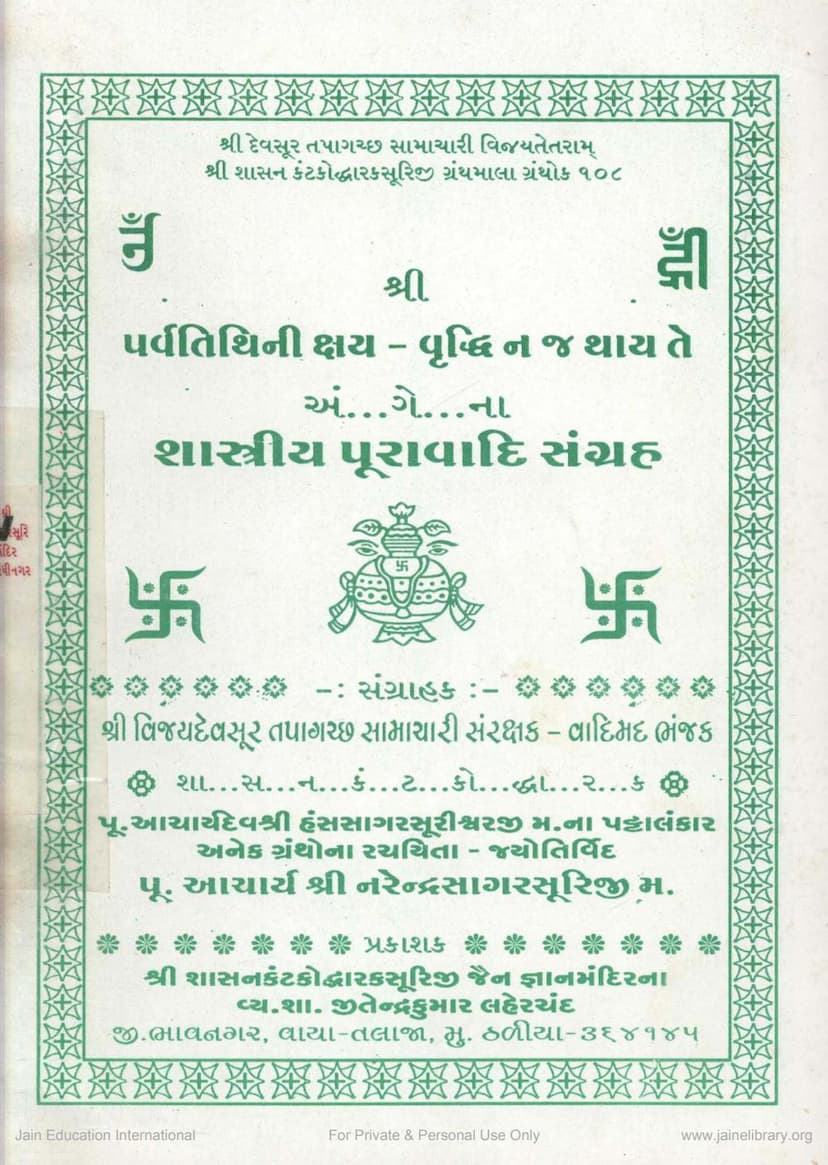Parvatithini Kshay Vruddhi Na J Thay Te Angena Shastriya Puravadi Sangrah
Added to library: September 2, 2025

Summary
This document is a collection of scholarly proofs and scriptural references supporting a specific Jain tradition regarding the waxing and waning of lunar dates (tithis), particularly concerning the dates of Paryushan and Samvatsari. The core argument is that when a festival date (Parva Tithi) itself wanes or waxes, the preceding or succeeding non-festival date (Aparva Tithi) should be adjusted accordingly, rather than the festival date itself being altered.
Here's a breakdown of the key points and arguments presented in the text:
Central Argument:
- The Principle: The primary principle established is that festival dates (like Purnima - full moon, Amavasya - new moon, Ashtami, Chaturdashi, and specifically Bhadrapada Shukla Panchami) should not themselves wane or wax. Instead, if a pava tithi is to be adjusted due to waxing or waning, the preceding aparva tithi should be adjusted.
- Waning (Kshaya): If a pava tithi wanes, the preceding aparva tithi should wane. For example, if Purnima wanes, the preceding Trayodashi (13th lunar day) should wane. If Bhadrapada Shukla Panchami wanes, the preceding Tritiya (3rd lunar day) should wane.
- Waxing (Vruddhi): If a pava tithi waxes (appears twice in a month), the preceding aparva tithi should also appear twice. For example, if Purnima waxes, the preceding Trayodashi should appear twice. If Bhadrapada Shukla Panchami waxes, the preceding Tritiya should appear twice.
Scriptural Basis and Evidence:
The document cites numerous scriptural texts, commentaries, and historical accounts (prats) to support its claims. Key supporting texts and arguments include:
- "Pakshik Vichar" (Page 4): An ancient text from 1792 VS (Vikram Samvat) clearly states that no festival date wanes or waxes according to Jain Agamas. It explains that if a Purnima wanes, Trayodashi is affected, and if Purnima waxes, Trayodashi also waxes. This same principle is applied to Bhadrapada Shukla Panchami and Tritiya.
- "Shravadh Vidhi" and other texts (Pages 5-8): These texts detail the principle that when Purnima or Amavasya wanes, Trayodashi should wane. Similarly, when they wax, Trayodashi waxes. The same logic extends to other festival dates like Ashtami and Chaturdashi, where the preceding aparva tithi is adjusted.
- Specific Rulings for Bhadrapada Shukla Panchami: The texts consistently argue that when Bhadrapada Shukla Panchami wanes or waxes, it's the Tritiya that should be adjusted, not the Panchami itself. This is because Chaturthi (the day before Panchami) is considered a causally significant (karanika) festival date, and therefore its waning or waxing is also governed by the preceding date.
- Historical Precedents and Debates: The document highlights historical instances and debates within the Jain community, particularly concerning the dates of Samvatsari.
- It mentions a conflict in 1992 VS when there were two Bhadrapada Shukla Panchamis. Different groups followed different interpretations: some adjusted Chaturthi, others adjusted Tritiya, and some stuck to the conventional Panchami. This led to debates about whether Samvatsari should be observed on a Thursday or Saturday.
- The work of Acharya Shri Anand Sagarsuri Maharaj is cited, who compiled these scriptural proofs to establish the tradition of adjusting Trayodashi for Purnima/Amavasya and Tritiya for Bhadrapada Shukla Panchami.
- Critique of Alternative Views: The document implicitly and explicitly criticizes interpretations that suggest adjusting the festival date itself (e.g., observing Samvatsari on a Saturday if Panchami is shifted, or adjusting the festival to a sixth day in some instances). It argues that these views are not supported by ancient tradition and scripture.
- The "Uday Tithi" Debate: The document touches upon the concept of "Uday Tithi" (the lunar day that extends into the sunrise) and argues that while the sunrise tithi is generally considered important for rituals, the core principle of aparva tithi adjustment for parva tithi waxing/waning remains paramount according to ancient traditions.
- "Jeeva Vyavahar" (Living Practice): The text also references the concept of "Jeeva Vyavahar" (practice of revered elders/scholars) and argues that the tradition of adjusting Tritiya for Panchami and Trayodashi for Purnima is a long-established "Jit Vyavahar" followed by numerous revered scholars and Acharyas of the Tapagachha.
Key Figures and Schools of Thought Mentioned:
- Acharya Shri Vijaydevsuriji Maharaj: The text is attributed to Narendrasagarsuri and published by the Shri Shasan Kantkodharaksuriji Jain Gyanmandir, highlighting the lineage and teachings associated with Acharya Vijaydevsuriji.
- Acharya Shri Anand Sagarsuri Maharaj: Credited with compiling scriptural evidence to support the tradition.
- Acharya Shri Hanssagarsuri Maharaj: The compiler, Narendrasagarsuri, is a disciple of Acharya Hanssagarsuri.
- Various other Acharyas and scholars: The text refers to the views and practices of figures like Acharya Vijayneshchandra Suri, Acharya Vijayramchandra Suri, Upadhyay Shri Vinayvijay, Pandit Rupvijay, Pandit Meruvijay, and others, indicating a broader scholarly discourse.
- Devsur Gachha vs. Tapagachha: There are references to differences of opinion between the Devsur Gachha and Tapagachha regarding these tithi adjustments.
Overall Purpose:
The book aims to collect and present scriptural evidence to firmly establish the correct tradition for observing Jain festivals, particularly Paryushan and Samvatsari, in cases of lunar date anomalies. It seeks to clarify and preserve the authentic tradition followed by the Tapagachha, countering alternative interpretations that it deems unscriptural or based on later innovations. The extensive citation of ancient texts and historical accounts serves to provide a robust and authoritative basis for this tradition.